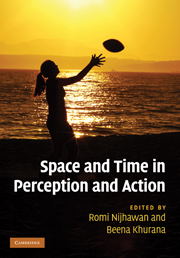Book contents
- Frontmatter
- Contents
- List of contributors
- Acknowledgments
- 1 Space and time: the fabric of thought and reality
- Part I Time–space during action: perisaccadic mislocalization and reaching
- Part II Temporal phenomena: perception
- Part III Temporal phenomena: binding and asynchrony
- 13 Dynamics of visual feature binding
- 14 How does the timing of neural signals map onto the timing of perception?
- 15 Mechanisms of simultaneity constancy
- 16 Relative timing and perceptual asynchrony
- 17 The time marker account of cross-channel temporal judgments
- 18 Simultaneity versus asynchrony of visual motion and luminance changes
- Part IV Spatial phenomena: forward shift effects
- Part V Space–time and awareness
- Index
- References
13 - Dynamics of visual feature binding
from Part III - Temporal phenomena: binding and asynchrony
Published online by Cambridge University Press: 05 October 2010
- Frontmatter
- Contents
- List of contributors
- Acknowledgments
- 1 Space and time: the fabric of thought and reality
- Part I Time–space during action: perisaccadic mislocalization and reaching
- Part II Temporal phenomena: perception
- Part III Temporal phenomena: binding and asynchrony
- 13 Dynamics of visual feature binding
- 14 How does the timing of neural signals map onto the timing of perception?
- 15 Mechanisms of simultaneity constancy
- 16 Relative timing and perceptual asynchrony
- 17 The time marker account of cross-channel temporal judgments
- 18 Simultaneity versus asynchrony of visual motion and luminance changes
- Part IV Spatial phenomena: forward shift effects
- Part V Space–time and awareness
- Index
- References
Summary
Summary
This chapter is concerned with the temporal aspects of visual binding. In particular, it concentrates on findings from studies of perceptual asynchrony between stimulus features and the temporal resolution of feature binding. I review the circumstances in which perceptual asynchronies are apparent versus those in which they are not. I argue that the existing data cannot be accounted for simply by a characteristic latency difference in the processing of different visual attributes (Moutoussis & Zeki 1997a,b) or by a scheme of temporal markers at salient stimulus transitions (Nishida & Johnston 2002). Instead, I outline a potential mechanism based on feedback from higher visual areas to primary visual cortex to account for the dynamics of binding color with orientation and direction of motion.
Introduction
How is the content of our conscious visual experience related to neural processing? Is our visual awareness an online monitor of visual processing, or do interpretative processes intervene to give conscious visual experience a postdictive quality? In the words of William James, “A succession of feelings, in and of itself, is not a feeling of succession. And because, to our successive feelings, a feeling of their own succession is added, that must be treated as an additional fact requiring its own special elucidation” (James 1890). But what is the nature of this “additional fact”? The simplest account would seem to be that the perceived sequence of events is directly related to the amount and duration of neural processing needed to achieve conscious experience (Jeannerod 1992).
Information
- Type
- Chapter
- Information
- Space and Time in Perception and Action , pp. 199 - 215Publisher: Cambridge University PressPrint publication year: 2010
References
Accessibility standard: Unknown
Why this information is here
This section outlines the accessibility features of this content - including support for screen readers, full keyboard navigation and high-contrast display options. This may not be relevant for you.Accessibility Information
- 7
- Cited by
